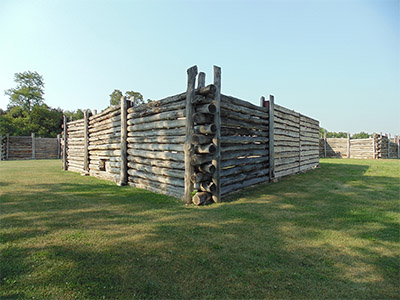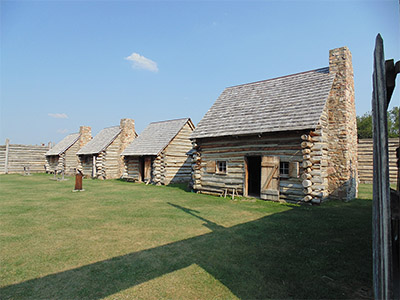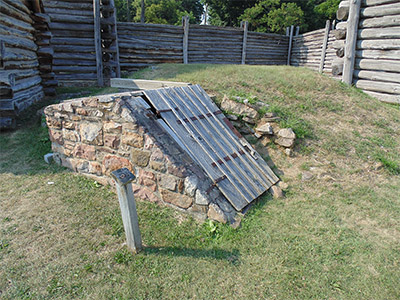 |
Fort Roberdeau
Sinking Spring Valley, Pennsylvania, USA
|
|
 |
Constructed: 1778
Used by: United States
Conflict in which it participated:
American Revolutionary War
Also known as:
The Lead Mine Fort
|
During the American Revolutionary War (1775-1783), one of the many challenges faced by the home team was that of arming its military. Then as now, America was a place where there were plenty of guns, whether for hunting or defense (or, more recently, just because AK-47s are really really cool)...but how does a brand-new notional nation provide enough ammunition to defeat what was arguably the greatest military force on earth at the time, the British Empire?
|
 |
|
|
Ammunition at the end of the 18th century meant lead, and lead there was in plenty in the Sinking Spring Valley region of Pennsylvania. In the Spring of 1778, an expedition set forth under the command of Brigadier General Daniel Roberdeau (1727-1795) of the Pennsylvania Militia (Roberdeau also represented Pennsylvania in the Continental Congress at the time), to find, mine and smelt lead, and to defend the whole process.
|
 Fort Roberdeau's southern bastion, with some of the recently-replaced woodwork visible to the right. Fort Roberdeau's southern bastion, with some of the recently-replaced woodwork visible to the right. |
 |
The region of Pennsylvania in question was swarming with wicked Tories, British Rangers and their Iroquois allies, all of whom were raiding Colonial settlements and pretty much making life (and death) miserable for supporters of American independence. The Tories most certainly had an interest in preventing patriotic lead mining, so who ya gonna call? A STARFORT!
Roberdeau oversaw the construction of his eponymous starfort from April to June of 1778, in a style he described in a letter to Commander-in-Chief of the Continental Army George Washington (1732-1799) as "Cabbin fashion." Due to the rockiness of the ground, the standard style of fort construction was impossible at this location. |
|
The preferred method of building a starfort in this era involved digging holes and emplanting wooden piles, which would serve as the foundation for earth-filled walls: Fort William Henry is an example of this method, which made for a stout defensive fortification indeed. "Cabin fashion" just means that logs were laid on the ground and walls were built in the style of a log cabin, with little shims of wood shoved into the inevitable openings betwixt logs. This was suitable for defense against Indians or Europeans with small arms, but woe betide a "Cabin fashion" starfort if the attacking force had any kind of artillery, or something as technologically advanced as fire at their disposal. |
Fortunately for the Pennsylvania Militia, local Tories and Indians apparently had not yet discovered fire, and had no artillery: Fort Roberdeau was never attacked. Reportedly, the first thing the fort's defenders did once the fort was completed was fire off all four of its 4-pounder cannon (one per bastion, mounted atop wooden walkways that went around the fort's interior), which served as an announcement to all within earshot that the Continental Army's lead mine was now strongly defended.
While the mines and their workers were directly protected by Fort Roberdeau, local settlers still had to deal with frequent Indian raids, and huddled within the fort's walls during periods of particular unpleasantness.
|
 |
 Fort Roberdeau's replica interior buildings, looking to the right just inside the main gate. Fort Roberdeau's replica interior buildings, looking to the right just inside the main gate. |
|
For the fort's first two years of existence, it also served as Bedford County's official storage depot for ordnance and ammunition. By 1781, France's increasing involvement in the war as America's ally greatly alleviated the need for local lead mining, plus the region in which Fort Roberdeau sat had become too dangerous for settlers to live. The fort was abandoned around this time, and gradually disintegrated.
|
 Fort Roberdeau's replica powder magazine. Sadly, the international scourge known as black mold has infected the interior of this noble edifice, and none may today venture inside. Fort Roberdeau's replica powder magazine. Sadly, the international scourge known as black mold has infected the interior of this noble edifice, and none may today venture inside. |
 |
In 1939, the site was excavated in the interest of determining the boundaries of Fort Roberdeau. This would have been a job indeed, determining where some logs had been placed atop the earth some 158 years previously!
In 1940 and 1941, the present fort's concrete-and-stone foundation was laid, but the United States' entry into the Second World War (1939-1945) at the end of 1941 changed some priorities, and there the star-shaped foundation sat for the next 32 years.
Until 1973, when the county began clearing the overgrown fort site. Over the next three years, Fort Roberdeau was rebuilt by Blair County, and was finally opened to the public on July 3, 1976: Just in time for Bicentennial events a-plenty! |
|
Today, Fort Roberdeau is open to the public for a small fee, and is undergoing another rebuilding effort. The oak logs with which the fort was reconstructed in the 1970's are getting a little ratty, and are in the process of being replaced. It is generally agreed today that the fort's original location was actually "a little ways up the hill," but its present spot seems like a very nice location for a fort, too.
|
|
|
|
|
|
 |




